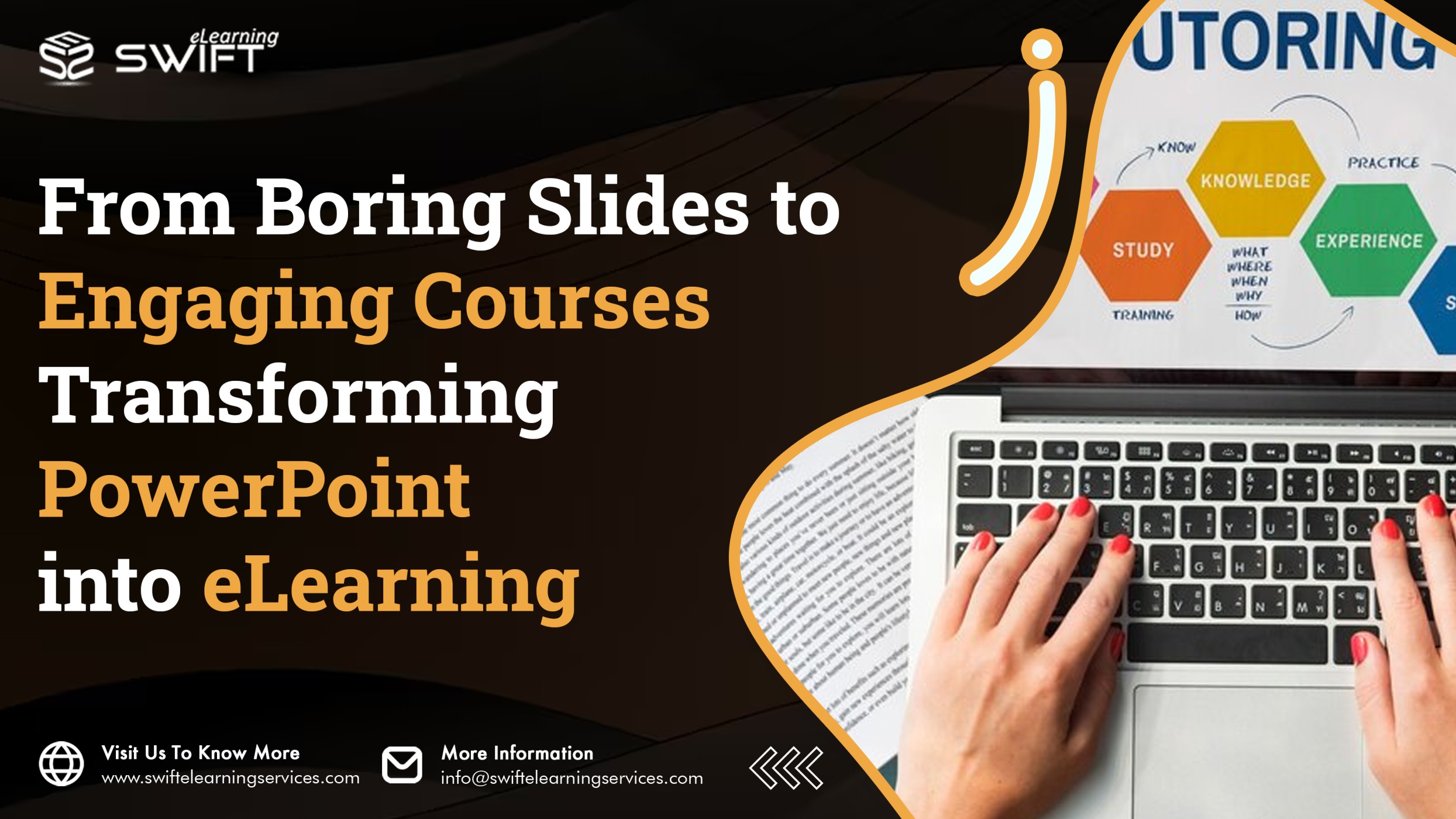From Boring Slides to Engaging Courses: Transforming PowerPoint into eLearning
In the rapidly evolving landscape of education and corporate training, the shift from traditional classroom-based learning to eLearning has proven to be transformative. The conversion of PowerPoint into eLearning has played a pivotal role in this evolution, offering unmatched flexibility, scalability, and accessibility, making eLearning an increasingly popular choice for organizations and institutions worldwide.
A pivotal aspect of successful eLearning is the transformation of static, text-heavy PowerPoint presentations into dynamic and engaging courses that captivate learners. In this comprehensive blog, we will explore the process of turning mundane slides into effective eLearning experiences that promote active learning, engagement, and long-term knowledge retention.
1. Transforming PowerPoint into eLearning: The Pitfalls of Boring Slides
Before we delve into the intricacies of transforming PowerPoint into eLearning, it’s essential to understand why traditional PowerPoint presentations often fall short in the context of eLearning:
1.1 Passive Learning: Traditional PowerPoint slides incorporated into eLearning often promote passive learning, where learners merely consume information without active engagement. This passivity can lead to reduced knowledge retention and a lack of motivation to learn.
1.2 Lack of Interactivity: PowerPoint slides are static and typically lack interactive elements that foster engagement and facilitate practical application of knowledge. it’s crucial to provide opportunities for learners to actively participate and put into practice what they’ve learned.
1.3 Limited Multimedia Integration: Text-heavy slides limit the integration of multimedia elements such as videos, animations, and audio. These multimedia elements are crucial for enhancing the learning experience, as they help convey complex concepts effectively.
1.4 Monotony: Lengthy text-based slides can quickly become monotonous and uninspiring, causing learners to lose interest and focus. Engaging eLearning should be a stimulating and immersive experience.
2. Empowering Learning: A Guide to Converting PowerPoint into eLearning
Now, let’s delve into the intricate process of transforming your conventional PowerPoint into eLearning courses:
2.1 Storyboarding and Content Structuring:
To initiate the transformation of PowerPoint into eLearning, begin the by crafting a comprehensive storyboard. The storyboard should outline the key learning objectives, topics, subtopics, and the overall flow of the course. A well-structured storyboard serves as the blueprint for your eLearning course.
2.2 Interactive Navigation:
When converting PowerPoint into eLearning, it’s vital to recognize the significance of structure and navigation. Rather than adhering to a linear progression of slides, consider implementing a menu-driven structure that allows learners to explore content in a non-linear fashion. This approach grants learner’s control over their learning journey, enhancing engagement.
2.3 Engaging Visual Design:
To elevate your PowerPoint into eLearning, make a substantial enhancement to your visuals. Invest in high-quality images, graphics, icons, and animations that make your content visually appealing. Furthermore, incorporate your organization’s branding elements to create a cohesive and professional look throughout the course.
2.4 Multimedia Integration:
Leverage multimedia elements strategically when transitioning from PowerPoint to eLearning. Incorporate videos, animations, and audio to explain complex concepts, demonstrate processes, and keep learners engaged. These elements serve as powerful tools to enhance the overall learning experience.
2.5 Gamification Elements:
Gamification can transform a dull eLearning course into an exciting learning adventure. Add gamified elements such as quizzes, interactive scenarios, leaderboards, and rewards to make learning enjoyable, competitive, and highly motivating for learners.
2.6 Interactivity:
When transitioning from PowerPoint into eLearning, make your eLearning course highly interactive by including activities like drag-and-drop exercises, clickable hotspots, and branching scenarios. Active participation reinforces learning, making it more memorable.
2.7 Responsive Design:
When converting PowerPoint into eLearning, ensure that your eLearning content is responsive, meaning it adapts seamlessly to various screen sizes and devices. This responsive design approach ensures that learners can access the course content comfortably on desktops, tablets, and smartphones.
2.8 Accessibility Features:
Maintain inclusivity by incorporating accessibility features into your eLearning course. Implement closed captions for videos, provide alt text for images, and offer keyboard navigation options to accommodate learners with disabilities.
2.9 Micro learning Segments:
As you convert PowerPoint into eLearning, consider breakingdown the content into bite-sized modules or lessons. Microlearning is highly effective in improving knowledge retention and learner engagement, as it allows learners to absorb information in short, focused bursts.
2.10 Assessment and Feedback:
As you transition from PowerPoint to eLearning, it’s essential to integrate regular assessments and quizzes throughout the course to gauge learners’ comprehension. Provide immediate feedback to reinforce correct answers and address any misconceptions is crucial. These assessments serve as valuable checkpoints in the learning journey, enhancing the overall learning experience.
2.11 Analytics and Tracking:
Utilize the capabilities of a Learning Management System (LMS) to track learners’ progress and performance. Analyze data to identify areas where learners may be struggling or require additional support. Data-driven insights are invaluable for continuous course improvement.
3. Sales Training Transformation: PowerPoint into eLearning Case Study
To illustrate the practical application of these transformation steps, let’s consider a real-world example of turning a traditional sales training PowerPoint into eLearning course.
3.1 Original PowerPoint Presentation:
The original sales training presentation consisted of densely packed, text-heavy slides with bullet points detailing various sales techniques. It lacked interactivity, engagement, and practical application, making it challenging for sales representatives to retain and apply the information effectively.
3.2 Transformation Steps:
Storyboarding: The transformation process began with the creation of a comprehensive storyboard. This storyboard outlined the course structure, including modules on prospecting, negotiation, closing deals, and customer relationship management.
Interactive Navigation: The eLearning course featured an interactive map interface that allowed learners to choose their learning path. This simulation of real-world sales scenarios gave learners a sense of autonomy and engagement.
Engaging Visual Design: The visual design of the eLearning course underwent a significant upgrade. High-quality images, infographics, and custom-designed graphics were incorporated to create a visually appealing and cohesive learning environment.
Multimedia Integration: Video demonstrations of successful sales pitches and negotiations were integrated into the course. These videos not only explained key concepts but also provided real-world examples for learners to emulate.
Gamification Elements: Sales simulations and role-playing exercises were introduced, allowing learners to practice their sales skills in a risk-free virtual environment. Leaderboards and performance metrics added a competitive element to the learning experience.
Interactivity: Interactive role-playing exercises challenged learners to apply their knowledge in simulated sales situations. They could make decisions and witness the consequences of their choices, enhancing their critical thinking and decision-making skills.
Responsive Design: The eLearning course was meticulously optimized for various devices, ensuring that sales representatives could access training materials on desktops, tablets, and smartphones, irrespective of their location.
Accessibility Features: To cater to diverse learners, the course included closed captions for all videos and provided alt text for images. Additionally, keyboard navigation options were available to accommodate individuals with disabilities.
Microlearning Segments: Each module was divided into bite-sized, self-contained lessons that focused on specific aspects of the sales process. This microlearning approach facilitated better information retention and allowed sales reps to fit learning into their busy schedules.
Assessment and Feedback: At the end of each module, learners encountered quizzes that assessed their comprehension. Immediate feedback and detailed explanations for correct answers were provided, ensuring that learners understood and retained the material.
Social Learning Integration: A dedicated discussion forum was established within the eLearning platform. Sales representatives could share success stories, exchange best practices, seek advice, and engage in meaningful discussions about their experiences in the field.
Analytics and Tracking: The Learning Management System (LMS) used to deliver the course tracked learners’ progress meticulously. This data allowed the training administrators to identify areas where sales representatives needed additional support or targeted training.
Results: The transformation of the sales training presentation into an engaging eLearning course yielded remarkable results. Sales representatives reported higher confidence levels in their abilities, and the organization observed a measurable increase in sales performance. The interactive and immersive nature of the eLearning course contributed significantly to these positive outcomes.
Conclusion
In conclusion, the journey from conventional PowerPoint into eLearning courses represents a profound shift in educational and corporate training methodologies. This transformation is characterized by the transition from passive information delivery to active learning and engagement. By thoughtfully incorporating interactivity, multimedia, gamification, and a range of other eLearning strategies, educators and trainers can create courses that captivate learners, enhance knowledge retention, and deliver tangible, real-world results.
It is essential to recognize that the key to successful eLearning lies not solely in the technology but in the deliberate design that promotes meaningful learning experiences. With the right approach, meticulous planning, and a commitment to continuous improvement, you can seamlessly transform your once-boring slides into dynamic eLearning adventures that empower, inspire, and prepare learners for success in an ever-evolving world.
Frequently Asked Questions (FAQs)
1. Why should I transform my PowerPoint into eLearning courses?
Converting your PowerPoint into eLearning courses enhances learner engagement, promotes active learning, and improves knowledge retention. It also allows for multimedia integration, making complex topics easier to grasp.
2. What is the first step in transforming a PowerPoint into an eLearning course?
Start by creating a storyboard that outlines your course’s structure, learning objectives, and content flow. This serves as the foundation for a well-organized and effective eLearning experience.
3. What role does interactivity play in eLearning transformation?
Interactivity is crucial in eLearning. It engages learners by allowing them to actively participate, make decisions, and practice what they’ve learned. It promotes a deeper understanding of the material.
4. How can gamification elements enhance eLearning courses?
Gamification, such as quizzes, leaderboards, and rewards, makes learning enjoyable and competitive. It motivates learners to complete courses and challenges, increasing their overall engagement.
5. Why is responsive design important in eLearning?
Responsive design ensures that your eLearning content adapts to various devices and screen sizes. It makes learning accessible on desktops, tablets, and smartphones, accommodating learners’ preferences.
6. What are some accessibility features that should be included in eLearning courses?
To cater to all learners, consider adding closed captions for videos, alt text for images, and keyboard navigation options. These features ensure inclusivity for individuals with disabilities.
7. How can micro learning segments benefit eLearning courses?
Micro learning breaks down content into bite-sized modules, improving retention and allowing learners to fit learning into their busy schedules. It encourages focused, efficient learning.
8. What role does assessment and feedback play in eLearning transformation?
Regular assessments and quizzes assess learner comprehension. Providing immediate feedback reinforces correct answers and addresses any misconceptions, enhancing the learning process.
9. Why is social learning integration valuable in eLearning courses?
Social learning fosters collaboration and discussion among learners. It creates a sense of community, allowing learners to share insights, seek advice, and engage in meaningful discussions about their learning experiences.
10. How can analytics and tracking improve eLearning courses?
Analytics and tracking, provided by a Learning Management System (LMS), allow you to monitor learner progress. This data-driven approach helps identify areas where learners may need additional support or targeted training, enabling course improvement.








Leave a Reply
Want to join the discussion?Feel free to contribute!